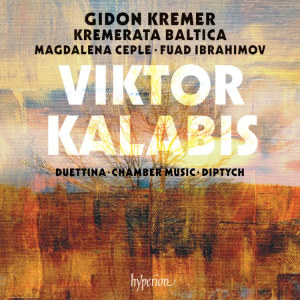
Viktor Kalabis (1923-2006)
Duettina for violin and cello, Op.67 (1987)
Chamber music for strings, Op.21 (1963)
Diptych for strings, Op.66 (1987)
Gidon Kremer (violin), Magdalena Ceple (cello)
Kremerata Baltica/Fuad Ibrahimov
rec. 2024, Pasaga Hall, Studio Residence Paliesius, Lithuania
Hyperion CDA68474 [53]
This 53-minute focus on Viktor Kalabis’ music for strings dates from the Chamber music for strings of 1963 to the two works composed in 1987. They share, in the main, a rather elegiac nature, one channelled through Kalabis’ distinctive use of material, and if your ear is attuned to the music of Martinů, a significant influence on Kalabis, you will recognise some salient features.
The Chamber music is the earliest and biggest of the triptych of works presented by Kremerata Baltica. It’s structured Prokofiev-style with two slow movements bisected by a fast one but initially inhabits a Bartókian world of night music, funereal and bleak, with a palpable sense of emptiness. Booklet writer Philip Clark has it just so when he writes that this first movement is ‘bleached’. It generates motion and intensity, though, and is never static, though Kalabis maintains its haunted and freighted nature to the very end. The fast movement might promise contrast and vivacity but it’s illusory – momentum generated collapses in on itself in a sequence of withdrawn sighs, then gathers again in tragic density. Hushed stasis haunts the finale, and where one might expect a sense of consolation, Kalabis instead provides none. There is no real sense of repose and no easy solution to the probing direction in which the music has led us.
However bleak this may sound, Kalabis’s astute ear always provides much to interest and intrigue. That’s just as true in the Duettina for violin and cello, played here by Kremer and Magdalena Ceple, a fine example of his ear for instrumental sonority. The first of the four movements is canonic and the second is based on Polka rhythms and has a crisply brusque charm. The refinement of the third movement Serenata is enhanced through its employment of canons and the finale unleashes athletic drive – crisp, decisive and attractive.
Also from 1987 is the Diptych for strings, a two-movement work that replicates the opening movements of the Chamber music for strings in its effect – an Andante followed by an Allegro vivo. However, it’s much more extrovert and tersely involved than the earlier melancholic string work. It encodes constant changes of texture and tempo in its opening seven-minute stretch which, when it reaches its apex, draws on Janáček-like figures. The fast finale, by contrast, evokes Kalabis’ Martinů inheritance, the music sounding concerto grosso-like and abruptly drawing on new material to build its structure.
Of the three works here, I’d suggest you start with the Diptych, then the Duettina and only then to draw further back to the unresolved bleakness of the Chamber music. Kalabis indeed had much about which to be bleak in 1963.
Kremerata Baltica is splendidly directed by Fuad Ibrahimov and in Kremer (of course) and the orchestra’s principal cellist, Magdalena Ceple, we have two proven exponents of the experimental. The recording has been very well judged, whether for two solo strings or the entire ensemble.
Kalabis has been well served by this release and my principal regret is that, whilst it makes for a focused piece of programming, there was room for another work.
Jonathan Woolf
Buying this recording via a link below generates revenue for MWI, which helps the site remain free



















